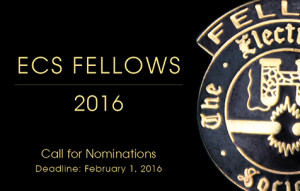 We are currently accepting nominations for the prestigious honor of Fellow of The Electrochemical Society. This award was established in 1989 for advanced individual technological contributions in the field of electrochemical and solid-state science and technology and for active membership and involvement in the affairs of The Electrochemical Society. The award consists of a scroll, lapel pin and eternal bragging rights.
We are currently accepting nominations for the prestigious honor of Fellow of The Electrochemical Society. This award was established in 1989 for advanced individual technological contributions in the field of electrochemical and solid-state science and technology and for active membership and involvement in the affairs of The Electrochemical Society. The award consists of a scroll, lapel pin and eternal bragging rights.
Now is the time to look around the room at your colleagues, recall that Division Member who you shared a meal with at our last bi-annual meeting or the committee member who you work with to further the ECS mission and question whether s/he is a Fellow. You may be very surprised at who has achieved this recognition and who has not. View the full list of ECS Fellows and take a moment to nominate the 2016 class.
Read the rules and submit a nomination form today.
Application Deadline: February 1, 2016.
2015 Class of Fellows
Simon Deleonibus: Known for his achievements and breakthroughs in process modules for future miniaturization of integrated circuits, Deleonibus realized what was the world’s smallest transistor early in his career.
Raymond J. Gorte: From his esteemed research on electrodes for solid oxide fuel cells to his position as Associate Editor of the Journal of The Electrochemical Society, Gorte has made a major impact on the scientific community.
Ellen Ivers-Tiffée: With more than three decades of research in the field of functional ceramics for the energy sector, Tiffée has touched many areas of both academia and industry with her innovations in electrochemical energy storage and conversion devices.
Deborah Jones: With a dedication to innovation in fuel cell and electrolyser materials, Jones has spent the past 20 years introducing new concepts for fuel cell membrane compositions.
Robert Kostecki: Often recognized for his groundbreaking work in the field of electrochemical energy storage and conversion systems, Kostecki’s work has helped bridge the gap between fundamental science and applications of significant technological importance.
Kailash C. Mishra: While bouncing between academia and national labs, Mishra directs his research toward the development of luminescent materials.
Mogens Bjerg Mogensen: From materials science to electrochemical kinetics to reversible fuel cells to energy conversion and storage, the research conducted by Mogensen has had a great impact across the scientific community.
Emanuel Peled: Best known as the inventor and developer of the solid electrolyte interphase (SEI) model for nonaqueous alkali-metal batteries, Peled’s deep exploration of batteries throughout his career yielded him much recognition.
E. Jennings (EJ) Taylor: With 35 years of experience in industrial electrochemistry, Taylor has been focused on developing innovative electrochemical technologies at both R&D laboratories and his own company, Faraday Technology.
John A. Turner: Upon joining the National Renewable Energy Laboratory in 1979, Turner began his expansive and innovative work on photoelectrochemical water splitting from hydrogen production.
Steven Visco: As the Founder and Chief Executive Officer of PolyPlus Battery Company, Visco has been featured by TIME magazine for his innovations in battery technology.

